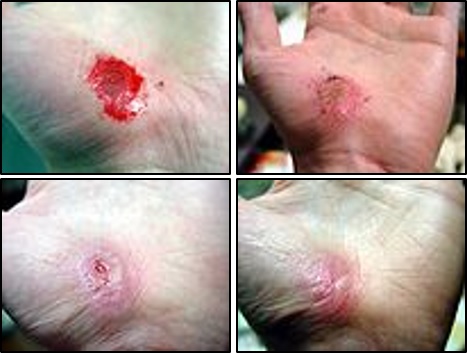TOPNURSE~In the beginning, long before Johnson met Johnson and Band-Aids were invented, primitive men and women suffered minor cuts and abrasions and probably left them uncovered to heal. After all, the bleeding had stopped, a scab eventually formed and experience had taught them that their skin would heal in a week or two. So there was no great rush to find a use for those puffy, cottony, soft, white plants growing in the fields just yet.
 In those early days of discovery, the scab and the blister were considered nature's miracle wound coverings. The scab became our partial and temporary exoskeleton and the blister was the human equivalent of bubble wrap, both protecting the wounds and encouraging the healing process. A scab is the body's natural wound covering. As long as the site is kept moist, the scab will not inhibit the healing process. At that time, keeping scabs and blisters intact seemed like the keys to wound healing.
In those early days of discovery, the scab and the blister were considered nature's miracle wound coverings. The scab became our partial and temporary exoskeleton and the blister was the human equivalent of bubble wrap, both protecting the wounds and encouraging the healing process. A scab is the body's natural wound covering. As long as the site is kept moist, the scab will not inhibit the healing process. At that time, keeping scabs and blisters intact seemed like the keys to wound healing.Drastic Wounds Call for Drastic Measures
But as time marched on and people suffered larger wounds (such as those that might be acquired while trying to take down a wild boar without decent weaponry), a need arose to stop excessive bleeding and further injury with some kind of wound covering. Trial and error most likely proved that palm leaves worked and poison ivy did not.
It wasn't until around 1500 BC that ancient Egyptians and Greeks started using lint, animal grease and honey as topical wound treatments. They had discovered that the lint provided a fibrous base that promoted wound site closure, the animal grease provided a barrier to environmental pathogens, and the honey served as an antibiotic agent.
What they may not have realized at the time was that their treatment method accelerated the wound healing process by promoting a moist wound bed.
What Is Moist Wound Healing?
There are two main components to moist wound healing: 1) Do not use disinfectants over the wound and 2) Keep the wound moist. The first component, not using disinfectants, makes sense because disinfectants such as iodine, sodium hypochlorite and hydrogen peroxide are toxic to cells and should never be applied over a wound surface. We don't want to kill cells; we want to encourage them to live and proliferate.
The second component refers to the fact that lacerations, abrasions, crush injuries and burns heal faster and with less scarring when treatment involves promoting a moist wound bed.
The proof that moist wounds heal faster than dry wounds came back in 1962, thanks to Dr. George D. Winter and his landmark paper, "Formation Of The Scab And The Rate Of Epithelialization Of Superficial Wounds In The Skin Of The Young Domestic Pig"1. His research showed that, contrary to the conventional wisdom at the time that wounds should be allowed to dry out and form scabs to promote healing, wounds instead heal faster if kept moist. Winter's work began the evolution of modern wound dressings that promote moist wound healing.
Specifically, cell growth needs moisture and the main goal of moist wound therapy is to create and maintain these optimal moist conditions. Cells can grow, divide and migrate at an increased rate to enhance the formation of new tissue. During this phase of wound healing, an aqueous medium with several nutrients and vitamins is essential for cell metabolism and growth.
The Role of Exudate in Wound Healing
In this environment, the wound exudate, the moisture that naturally seeps out from a wound site, serves as a transport vehicle for a variety of bioactive molecules such as enzymes, growth factors and hormones. The different cells in the wound area communicate with each other via these mediators, ensuring that the healing processes proceed in a coordinated manner.
Wound exudate also provides the different cells of the immune system with an ideal medium to destroy invading pathogens such as bacteria, foreign bodies and necrotic tissues, diminishing the rate of infection.
Moist wound healing inhibits the formation of a solid, impenetrable scab, which tends to block the epithelial cells from spreading horizontally through the thin layer of wound exudate and across the wound bed. The wound is then able to close quickly. In addition, pain is significantly reduced when wounds are covered with an occlusive dressing. At first, there were concerns that the presence of moisture in wounds would increase the risk of clinical infection, but that has been shown not to be the case.
To summarize, treating topical wounds is broken down into the following components:
- Cleaning the wound in order to remove dead tissue and debris
- Dressing the wound to promote a moist wound bed and to prevent reinjuring the site
- Determining the frequency of dressing changes
- Reevaluation to measure the rate of healing
Following this protocol provides:
- Up to 50% faster wound healing than dry wound healing
- A lower rate of infection
- No need of systemic antibiotics
- Painless removal of the dressing without damaging newly formed tissue
- Less scarring and better cosmetic results







0 comments:
Post a Comment